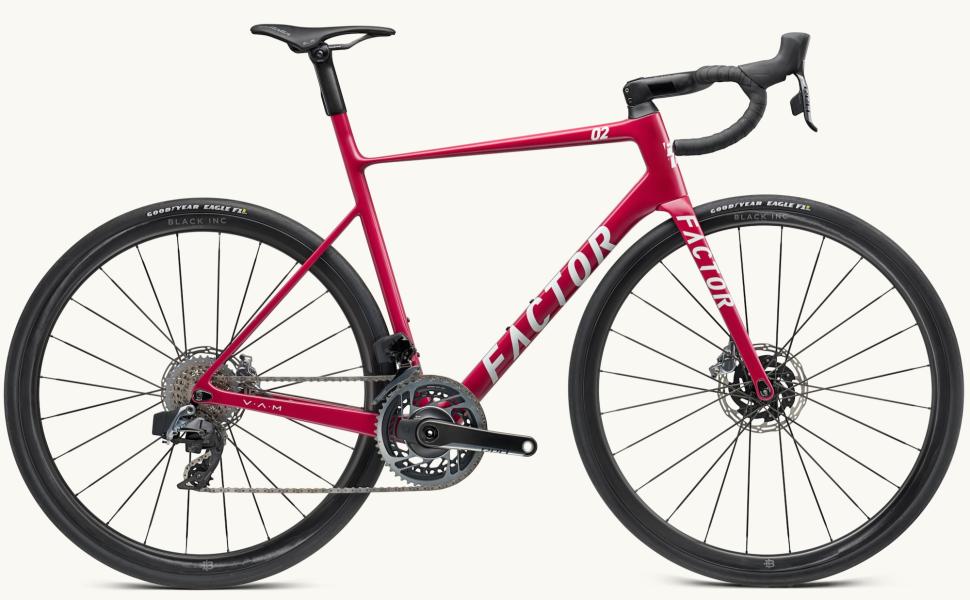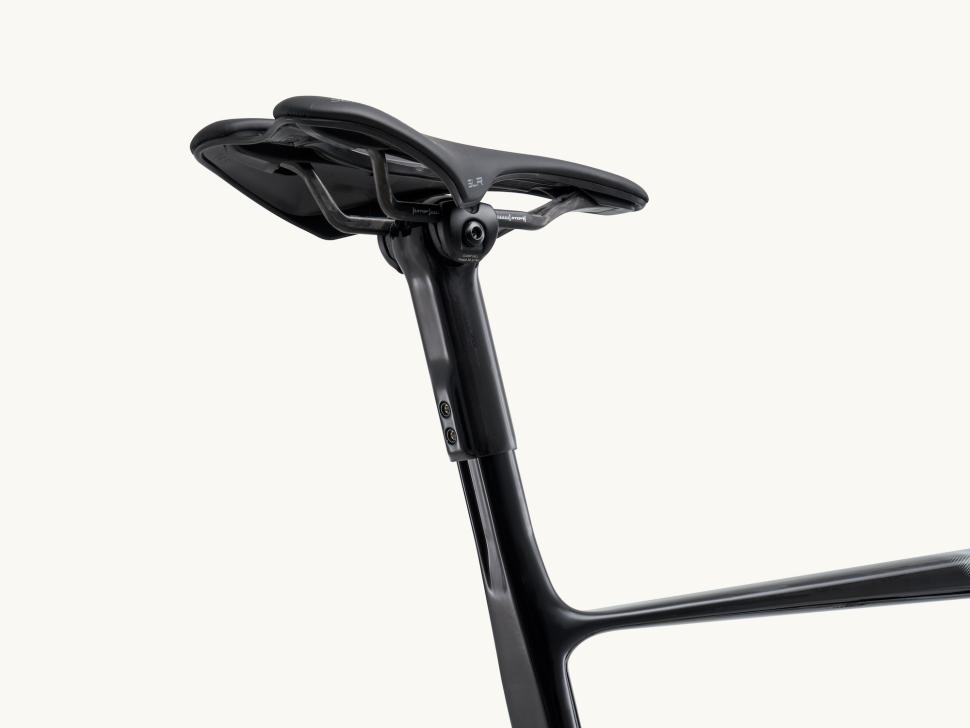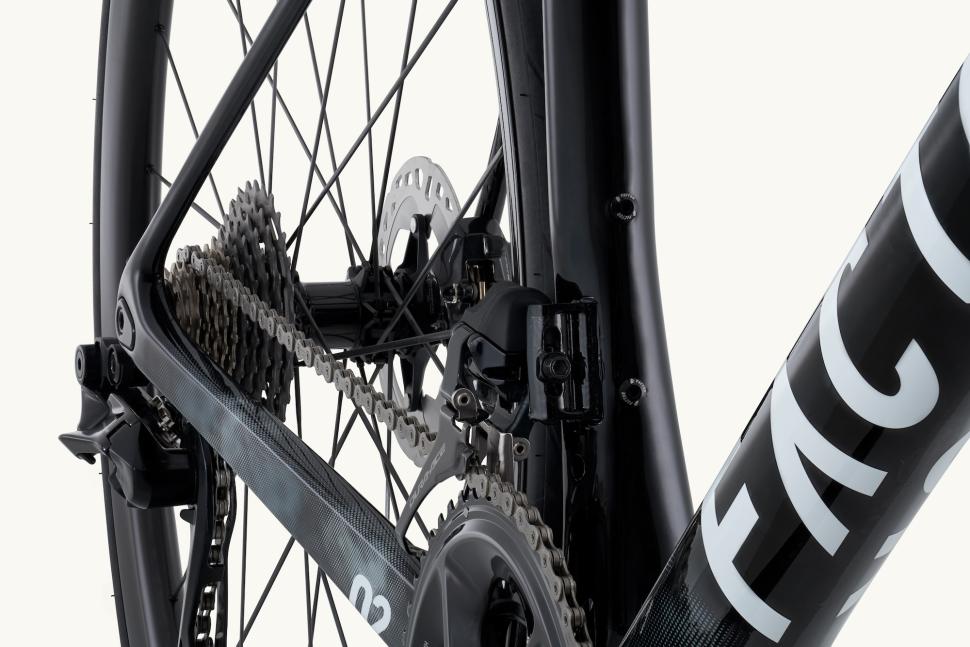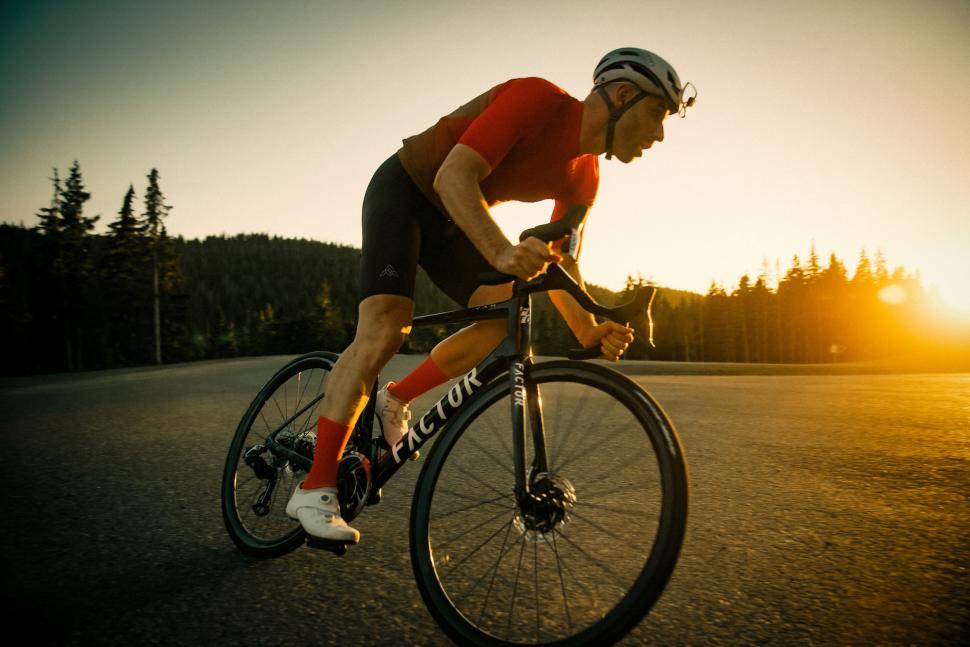- News
- Reviews
- Bikes
- Components
- Bar tape & grips
- Bottom brackets
- Brake & gear cables
- Brake & STI levers
- Brake pads & spares
- Brakes
- Cassettes & freewheels
- Chains
- Chainsets & chainrings
- Derailleurs - front
- Derailleurs - rear
- Forks
- Gear levers & shifters
- Groupsets
- Handlebars & extensions
- Headsets
- Hubs
- Inner tubes
- Pedals
- Quick releases & skewers
- Saddles
- Seatposts
- Stems
- Wheels
- Tyres
- Tubeless valves
- Accessories
- Accessories - misc
- Computer mounts
- Bags
- Bar ends
- Bike bags & cases
- Bottle cages
- Bottles
- Cameras
- Car racks
- Child seats
- Computers
- Glasses
- GPS units
- Helmets
- Lights - front
- Lights - rear
- Lights - sets
- Locks
- Mirrors
- Mudguards
- Racks
- Pumps & CO2 inflators
- Puncture kits
- Reflectives
- Smart watches
- Stands and racks
- Trailers
- Clothing
- Health, fitness and nutrition
- Tools and workshop
- Miscellaneous
- Buyers Guides
- Features
- Forum
- Recommends
- Podcast
TECH NEWS
 2023 Factor O2 VAM - 1 (1)
2023 Factor O2 VAM - 1 (1)Factor launches new O2 VAM as “the world’s fastest climbing bike”
Factor has unveiled a new version of its O2 VAM road bike which it calls “the world’s fastest climbing bike”, coming with a frame that weighs a claimed 730g, including its external seat post. Factor says that the updated O2 VAM can be built up into complete bikes that weigh as little as 6.2kg and that it’s possible to hit the UCI’s 6.8kg minimum weight limit for racing with the pedals, transponder and race number attached. The bike, which also includes aerodynamic features like D-shape truncated aerofoil tube profiles, will be used in the 2023 Tour de France by Israel-Premier Tech.
Factor says that the O2 VAM is the equivalent of 12W more efficient than the previous model when measured in the wind tunnel at yaw angles from +15° to -15° at 48km/h. In other words, you can achieve the same speed while putting out less power. Although the bike can take tyres up to 32mm wide with 4mm clearance all around, it is optimised for 28mm.
Factor is launching the updated O2 VAM with some strong claims.
“The new O2 VAM is an aero climbing bike – nothing else this light is as fast, nothing this fast is as light,” Factor says. “It’s the ultimate choice for riders seeking performance on big days in the mountains, whether you’re riding the Étape du Tour or the Tour de France.
“The new O2 VAM is for everyone looking for an enhanced, faster ride experience on mountainous and hilly terrain, with quicker climbing, more confident descending, higher speed on the flats and greater comfort. It’s for gran fondo riders, racers, and those for whom a week in the mountains is the highlight of the year. If speed isn’t your priority, the increased efficiency will save you energy to ride further.”
The previous-generation O2 VAM was lightweight but it didn’t bring much to the party in terms of aerodynamics, and there has been a big trend in the road bike world to combine the two attributes over the past couple of years.
Graham Shrive, Factor’s Director of Engineering, says, “We began by asking the riders of the Israel-Premier Tech team ‘On what terrain do you get your results and how can we help that?’ They wanted a bike that would be under 7kg in race trim, with pedals, transponder and number.
“Then we asked, ‘What’s stopping you from riding the previous O2 VAM?’ They said aero and stiffness. So, we made the new O2 VAM as stiff as the Ostro VAM, a 35% increase, and 12W faster than the old O2 VAM in the wind tunnel, which is around half the difference to the Ostro VAM and at low yaw angles of 0-5 ̊ it’s only 5W behind.”
As if to reiterate how much the peloton values aero and stiffness nowadays, Michael Woods rode what appeared to be an Ostro VAM aero road bike for his stunning Tour de France stage 9 victory on the fearsome and iconic Puy de Dôme yesterday (we're not entirely sure why Woods didn't use the new O2 VAM).
> Why lightweight aero bikes are now THE essential race weapon
Factor says that it has increased ride comfort through the external seatpost and thin top tube, “which reduces to 10mm to promote controlled deflection at the saddle over bumps”. This exploits recently revised UCI rules on frame dimensions.
The ride position has been altered in response to customer fit data and the fact that people tend to sit more upright when climbing than they do on the flat. There’s a 10mm increase in stack height across the size range which is designed to reduce the use of headset spacers.
Developing the new Factor O2 VAM
Factor says that it set “ambitious goals for weight, stiffness and aero” when it began the project. Among its aims was to develop the most aerodynamically efficient frame it could at 700g, while other bikes at this weight use predominantly round tube shapes and little or no cable integration. Factor also says it wanted to push the limits of the recently updated UCI rules to develop new tube shapes and “to optimise aerodynamics for real-world relevant speeds”.
It first set about developing a range of tube shape options using finite element analysis (FEA) and computational fluid dynamics (CFD) to look at structural and aerodynamic performance.
“Computational studies were carried out on aero profiles at a range of speeds and wind angles, on tube cross-sections as a predictor of mass, and on wall thickness versus section area,” says Factor. “An intricate optimisation process identified the shapes with the best balance of aero, stiffness and lightness.”
Factor says that it used CFD that can model spinning wheels and a pedalling rider, and measure the drag from individual components. It ran its complete preliminary designs through the software before taking them to the wind tunnel for aero testing. It then tested prototypes in-house before final prototype testing was performed by Israel-Premier Tech riders.
Loads of brands have been making their lightweight bikes more aero over the past few years – think of the Specialized Tarmac SL7 and the Trek Emonda, for example – so it’s no surprise to see Factor go down this route.
> Check out our Specialized S-Works Tarmac SL7 Dura-Ace Di2 review
“Why make an aero climbing bike?” Factor asks. “Firstly, because the climbs are only part of anyone’s ride, and on the rest of any route, aero is as important as ever. Secondly, because the pros climb so fast that aero remains a significant consideration even at typical gradients of 8%.”
Factor says that a light weight becomes more important than aerodynamic considerations at about that incline for pro riders, but that reducing drag can still produce significant gains when it gets steeper.
Of course, aero tube profiles tend to be deeper than standard shapes and the extra material increases weight, so the difficulty is to combine aerodynamics and lightness.
“Drawing and expanding on learning from the Factor Ostro Gravel - the world’s fastest gravel bike - the team created entirely novel airfoil shapes for the down tube, seat tube and head tube” says Factor. “These aero profiles use aggressively truncated airfoils which deliver a very high stiffness-to-weight ratio with minimised drag achieved by manipulating the separation and reattachment of the airflow.
“A focus on optimising the frontal area for low yaw conditions means that at 0-5 effective wind angle the new O2 VAM is only 5W behind the Ostro VAM, which itself is the fastest aero bike on the market. The new O2 VAM is not only the fastest bike in its category, but also faster than many brands’ much heavier dedicated aero offerings.”
Factor has stuck with 1.25in bearings in the head tube in order to keep the frontal area as small as possible and the truncated NACA-profile seat stays are at the UCI’s minimum 10mm thickness.
The seat tube reaches across the full width of the bottom bracket but tapers significantly as it extends upwards. The idea is to combine stiffness and aero performance. The slimness up top is designed, with the flattened top tube “to enhance in-plane compliance for comfort and energy dissipation.”
New Black Inc wheelset
Factor’s in-house component brand Black Inc is also introducing a new 28//33 tubeless wheelset that is “designed to complement the new O2 VAM”. As the name implies, the front wheel has a 28mm depth while the rear is – and you might be one step ahead here – 33mm deep.
The internal width is 23mm and the external width is 28mm and the rims are optimised for 28mm tyres. The wheels are built with carbon fibre spokes and Factor claims a weight of just 1,146g.
Factor hasn’t gone hookless for the road – although it does for gravel – preferring to use what it calls a ‘mini hook’ to help keep the tyres in place, which makes us think of the approach that Orbea’s Oquo brand has recently taken with its new road and gravel wheel range.
> Orbea’s Oquo brand launches its first road and gravel wheel range using ‘mini hook’ system
“As well as a substantial weight saving, they also reduce drag by 10g from the previous Thirty wheelset and greatly boost stiffness, and therefore responsiveness and acceleration,” says Factor.
The 28//33 wheelset is available separately at a price of £2,900.
New tech
Factor says that the introduction of a new research and development facility in Taiwan has helped in the genesis of the new O2 VAM.
“The rate of prototype iteration has moved from three weeks to one day and a new compaction method has been developed, the details of which are secret and proprietary,” it says.
Factor does disclose that the new O2 VAM uses a similar mix of fibres to the existing Ostro VAM, including T1000 and M60J.
“Boron is used in the external seatpost to achieve an extreme strength-to-weight ratio,” Factor says. “Over 40 iterations of the layup schedule were prototyped and tested and all seven frame sizes have a unique kit of carbon fibre laminate and a unique layup schedule, ensuring optimal ride quality for all riders.”
Models and prices
The Factor O2 VAM is available now in these builds:
- Shimano Dura-Ace 9170 Di2 £11,800
- Shimano Ultegra 8170 Di2 £9,900
- SRAM Red eTap AXS + Quarq PM £12,200
- SRAM Red eTap AXS £11,800
- SRAM Force eTap AXS + Quarq PM £10,100
- SRAM Force eTap AXS £9,900
- Frameset £6,300
- Frameset + Black Inc 28/33 wheels £8,900
Mat has been in cycling media since 1996, on titles including BikeRadar, Total Bike, Total Mountain Bike, What Mountain Bike and Mountain Biking UK, and he has been editor of 220 Triathlon and Cycling Plus. Mat has been road.cc technical editor for over a decade, testing bikes, fettling the latest kit, and trying out the most up-to-the-minute clothing. He has won his category in Ironman UK 70.3 and finished on the podium in both marathons he has run. Mat is a Cambridge graduate who did a post-grad in magazine journalism, and he is a winner of the Cycling Media Award for Specialist Online Writer. Now over 50, he's riding road and gravel bikes most days for fun and fitness rather than training for competitions.
Latest Comments
- Born_peddling 1 hour 3 min ago
Muddyfox tour 100's I've wide & flat feet plus there's the optional choice of using cleats with them...
- Prosper0 58 min 7 sec ago
Just doing the Lord's work in case anyone's interested in this product. This Mucoff Pump is a £100 rebrand of an £85 Rockbros rebrand of a £60...
- mdavidford 1 hour 42 min ago
You forgot ignoring half the race to show awkward interviews with the riders' Proud Parents™ instead.
- mdavidford 1 hour 46 min ago
Obviously it means 'springing out of the bunch' on a critical sector. Or maybe it's referring to the time of year.
- David9694 2 hours 33 min ago
Car crashes through garden wall for second time in 18 months https://www.wiltshire999s.co.uk/car-crashes-garden-second-time/
- David9694 2 hours 35 min ago
Woman taken to hospital after flipping car onto roof in Trowbridge...
- A V Lowe 3 hours 17 min ago
Its blindingly obvious from the image that the DKE of the buses include the mirrors which extend to nearly reach the edge of the tarmac pavement on...
- Sredlums 3 hours 50 min ago
It's sad when being very good at your job - any job - isn't enough to earn a decent living. It shouldn't be that way....


































Add new comment
9 comments
Yeah, but what's it like on the descents?
Looks like a Titici Vento but not as pretty
Now if they'd had the nerve to go for the Titici F-R102 look...
Dagnammit - my comment was deleted and it had at least one like
Were they waiting until the bike won something to release it or is Mike Woods just really in tune with the marketing department?
Also - why is the Ultegra version £1k more than the dura-ace....
Updated. The DA price was wrong. Apologies
Michael Woods wasn't actually on the new bike.
Wow, imagine what he could have done on the new one then!
He would have taken off and flown to the top! I bet Factor are feeling quite sore today that he didn't ride it and give it a Tour stage winning launch. The marketing department could have had plenty of fun there.
Probably almost the exact same as he did on the Ostro, seeing as he would have had to (theoretically) expend a little more energy earlier in the stage on the flatter part of the route the O2 would probably have put him in about the same net position.
Sorry, it was a tongue in cheek comment - probably should have added an emoji. It's not like the current bike range was holding him back.